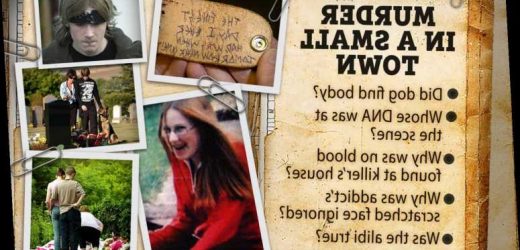THE murder of 14-year-old Jodi Jones’ in 2003 shocked the tight-knit community of Dalkeith, Scotland, and led to the conviction of her boyfriend Luke Mitchell, at the age of 16.
But 17 years on a Channel 5 documentary, Murder in a Small Town, has set out to question whether Mitchell, who was jailed for 20 years, was the real killer.
Jodi went missing on the night of June 30, 2003, after leaving her home to walk down a woodland path to meet Mitchell.
After forming a search party with her family, several hours later, 14-year-old Mitchell was the first to find her body behind a low wall running along the path.
Her hands were tied behind her back with her own trousers, she had been stabbed multiple times and had her throat cut.
Mitchell, arrested for the murder 10 months later, pleaded not guilty at his 2005 trial and has always maintained his innocence – despite losing three appeals.
Jodi's devastated family still believe he committed the crime and his conviction should be upheld.
Yesterday, as part one of the documentary aired, Jodi's mum Judith posted on social media: "Truth will always be truth, regardless of lack of understanding, belief or ignorance."
But in the documentary, two former police officers who now work as private investigators raise numerous questions about the case, including the lack of forensic evidence linking Mitchell to the crime.
The two-parter reveals that DNA from two other men was found at the crime scene – while Luke’s DNA was absent – and also claims that leads on five other suspects were never followed up.
Police Scotland deny the claims saying they are "satisfied" that a thorough investigation was carried out and that "no other individuals" needed to be traced.
So could Luke Mitchell be innocent? Ahead of the second episode airing, we examine the questions that still need to be answered.
Why didn’t Mitchell raise the alarm sooner?
Jodi, who had been dating Mitchell for three months, left her home at around 5pm on the night of the murder but the alarm was not raised until after 10pm, when she failed to return home.
Her mobile phone was broken but at 5.40pm, Mitchell spoke to Jodi’s stepdad, Allan Ovens, who said she had already left to meet him.
Mitchell later told the police that there were any number of reasons why she would not turn up, and said he wasn’t initially concerned.
How did Mitchell know where to find the body?
After she failed to come home by 10pm her sister Janine, gran Alice and boyfriend Steven Kelly met with Mitchell and his Alsatian, Mia, to form a search party at the path, known as Roan’s Dyke.
After walking past a V-shape gap in a stone wall, at the side of the path, Mitchell claimed his dog sniffed the air and led him to look behind the wall, where he found Jodi’s body.
The new documentary claims the family’s original statements mentioned Mia sniffing the air but all three told the trial they didn’t remember that.
The fact that Mitchell was first to find the body was later used by the prosecution to imply “guilty knowledge”.
Whose DNA was found at the crime scene?
A used condom containing “fresh semen” was found near the body but the unnamed source was not traced until three years later, when his DNA was put through the police database in relation to a different incident.
Allan Jamieson, Head of the Forensic Institute, tells the documentary: “Given the nature of the crime, a young girl attacked, the condom should have been given more significance than it apparently was.”
Another man’s DNA was also found on Jodi’s T-shirt, which she had borrowed from her sister, but he was not treated as a suspect.
Mitchell’s DNA was not found at the crime scene.
Was Jodi’s blood found on Mitchell’s clothes or in his house?
According to Jamieson, the brutal murder would have resulted in the killer’s clothes being soaked with blood.
Mitchell would have had to have gone home, showered and changed and disposed of the clothes before joining the search party – meaning there would be blood traces on door handles and taps.
But no trace of Jodi’s blood was found anywhere at his home, or on his clothes.
When he was taken to the police station later that night, he was stripped and searched and he was described as having dirty fingernails and hair, suggesting he hadn’t showered.
The prosecution alleged that his clothes had been burned in a woodburner in the family's garden, but there was no forensic evidence to back the claim.
A parka coat that Mitchell was alleged to have worn was never found.
What was Mitchell’s alibi?
Mitchell claimed he was cooking dinner at home when Jodi was murdered and his mum, Corinne, backed his alibi.
But during the trial his older brother admitted he had been watching internet pornography in the house at that time, and that he would only have done so if he thought he was alone.
Corinne Mitchell was initially arrested for perjury but the charges were dropped.
Why wasn’t anyone else suspected?
The documentary claims that Luke Mitchell was treated as the only suspect from day one, and points to various leads which could have led the enquiry elsewhere.
As well as the two DNA samples, there were sightings of two local lads, known as the ‘Moped Boys’, whose bike was seen propped against the wall at 5.15pm, around the time Jodi died.
One was said to have hacked his long hair off with a pair of scissors in the days after. They took five days to come forward to police.
John Sallens and Michael Neil, the former cops investigating the case, say Jodi put up a fight and that her killer would to have “scratches and bruises.” Luke had none.
But Scott Forbes tells the documentary that another local man, named as Mark Kane, turned up at his Edinburgh home the night after the murder with three deep scratches on his face.
He told Forbes he had been taking methadone, valium, speed and alcohol in the woods the night before and had “fallen in a bush.”
Forbes described Kane, who died shortly before the documentary was filmed, as a “very disturbed” student who carried an 8in kitchen knife.
In a photo shown on the documentary, he bears a passing resemblance to Mitchell.
In 2005, Chief superintendent Craig Dobbie, of Lothian and Borders Police denied claims the force had ignored other potential suspects.
“We interviewed everyone possible," he said. "We interviewed every male who had been viewed with general suspicion.
"That group included any males known to Jodi – both relatives and friends.
Why was he found guilty?
The main argument in the prosecution was that Mitchell being the first to find Jodi’s body suggested he already knew where it was.
They also pointed to Mitchell’s love of Marilyn Manson and claimed he had an obsession with the Black Dahlia case – the 1947 murder of Eliabeth Short, whose body was found severed in two in LA.
The court also heard that Mitchell was a heavy user of cannabis who collected bottles of urine in his bedroom.
A knife pouch was found in Mitchell's room on which he had written, "JJ 1989 – 2003" and "The finest day I ever had was when tomorrow never came".
Although the knife was bought after the murder, the prosecution said it would be unlikely for anyone but the killer to remember a victim in this way.
Eye witness Andrina Bryson testified that she had seen teenagers answering the couple's description, in the entrance of Roan’s Dyke shortly before Jodi died.
However, she was unable to identify Mitchell in court as the person she had seen.
Luke Mitchell,who was jailed for a minimum of 20 years and is still in jail, continues to protest his innocence and told the documentary: "I’ve been locked up for a crime I didn’t commit."
But Police Scotland issued a statement, denying the claims the conviction is unsafe.
Detective Chief Superintendent Laura Thomson said: “Following the discovery of 14-year-old Jodi Jones’ body within a wooded area in Easthouses, Midlothian, on 30th June 2003, a thorough investigation was conducted by Lothian and Borders Police.
“Extensive forensic analysis was carried out along with door-to-door inquiries and other investigative techniques and a full report of the circumstances was submitted to the COPFS.
“As a result, Luke Mitchell, who was 15 at the time, was charged with Jodi’s murder, before being convicted and sentenced in 2005.
We are satisfied that we do not need to trace any other individuals in connection with this investigation.”
Murder in a Small Town concludes tonight at 9pm, on Channel 5
Source: Read Full Article
















